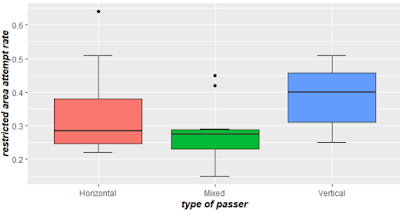The purpose of this analysis is to find firstly whether there is any correlation between a player that attacks the rim and finishes often at the rim (aggressiveness) and the number of assists that he makes. Secondly, to find the possible correlation between the player's aggressiveness and the ration of assists that he makes for each type of shot. Finally, we classify assist-men based on where they assist and then we find what type of passers most impact on team shooting efficiency when he is on the court.
ASSIST-MEN AND AGGRESSIVENESS TO THE RIM
DEFINING ZONE IN BASKETBALL COURT AND DEFINITION OF SHOT TYPE
Basketball court is divided into eleven zones as shown in the picture below.
In zone 1 we define the Restricted Area (abbreviated as RA) where players take short-range shots.
From zone 2 to zone 6 we define the Mid-range while from zone 7 to zone 11 we have the Three Points Area where players take long-range shots.
DEFINING DATASET
The dataset contains useful information such as the name of the shooter, shot location on the field and assistman (in case the basket was assisted). We consider a sample of 36 players, the 2 best assist-men for each team in terms of total assists made during the 2020-2021 EuroLeague season.
DEFINING INDEX OF AGGRESSIVENESS
To find and quantify the ability of a player to attack the basket and be aggressive we define a new metric, derived from the dataset: Restricted area attempt rate.
A higher ratio stands for an attack minded player that finishes at the rim rather than a perimeter player. Having a player with the ability to attack is a huge advantage for the offense because the defense is forced to collapse and the teammates have space to move around without the ball or waiting in the perimeter to shoot a triple.
AGGRESSIVENESS AND ASSIST
Looking at possible correlation between a player who attacks the rim and finishes often at the rim (aggressiveness) and the number of assists that he makes, we find a WEAK NEGATIVE TREND which means that the more a player finishes at the rim the less assists he will distribute.
However the correlation, that is equal to -0.0133, is very weak so the two quantities can be considered independent. Therefore, the aggressiveness of a player has no correlation with the quantity of assists that he makes.
AGGRESSIVENESS AND ASSIST BY ZONE
Looking at possible correlation between a player's aggressiveness and the ratio of assists that he makes for each type of shot, we notice that a higher restricted area attempt rate is negatively correlated with a higher proportion of assists to the three pointers.
Instead there is a positive trend in terms of restricted area attempt rate and the proportion of assists to the restricted area.
FINAL RESULTS
When a player creates an advantage and the defense collapses he either passes the ball inside to the center for an easy shot or he passes the ball to the perimeter.
When a shooter receives the ball in the perimeter he can obviously shoot but it is also likely that he passes the ball to another shooter and builds on the advantage created by his teammate (extra pass). This is why for further research (with the help of tracking data) we expect that a higher restricted area attempt rate is positively correlated with the number of assists + the number of passes that generate an assist
ASSIST-MEN CLUSTERING BASED ON WHERE THEY ASSISTED AND TEAM SHOOTING EFFICIENCY
CLUSTERING ALGORITHM
In order to define the categories for assist-men, we use the K-means clustering algorithm. K-means is an unsupervised clustering algorithm that identifies groups of similar players by using the Euclidean distance between observations of a data set. The number of selected clusters to identify the categories of passers is 3.
DATA AND CLUSTERING PROCESS
CLUSTER 1 - VERTICAL PASSERS
Players with a high proportion of assists to the restricted area.
Often assists to the restricted area are vertical passes. This is why we label players in this cluster as vertical passers.
CLUSTER 2 - HORIZONTAL PASSERS
CLUSTER 3 - MIXED PASSERS
Players with a balanced proportion of assists to all areas of the court. This is why we label players in this cluster as mixed passers.
AGGRESSIVENESS AND ASSISTMEN TYPE
We look at the Restricted Area attempt rate of the three clusters to see which prototype of passers is more likely to attack and finish at the rim. The results are shown in the chart below.
From the boxplot the cluster of vertical passers seems to be more aggressive in terms of finishing in the paint compared to the other clusters.
TEAM SHOOTING EFFICIENCY AND ASSISTMEN TYPE
Once performing the k-means algorithm and finding the three categories of passers such as Vertical,Horizontal and Mixed, it is interesting to look at how those categories impact their teams, when they are on the court, in terms of shooting volume and efficiency from the different areas of the court.
So we use another database that contains ON-OFF stats of each player.
PASSERS CLUSTERS IMPACT ON TEAMS SHOOTING CHART
FINAL RESULTS
- With mixed passers on the court, teams are more efficient both in the restricted area and in the other areas of the court.
- With horizontal passers on the court, the team's shot distribution is, as expected, unbalanced towards the mid-range and threes and the respective eFG% in those zones is just slightly better compared to the one of the vertical passers.
- With vertical passers on the court the team’s eFG% in the restricted area is better than the one of Horizontal passers.
Therefore, when a player is able to balance his assists between inside and outside the area (mixed passes), team play becomes less predictable and therefore more effective.
AUTHOR: Tommaso Del Prete


















Comments
Post a Comment